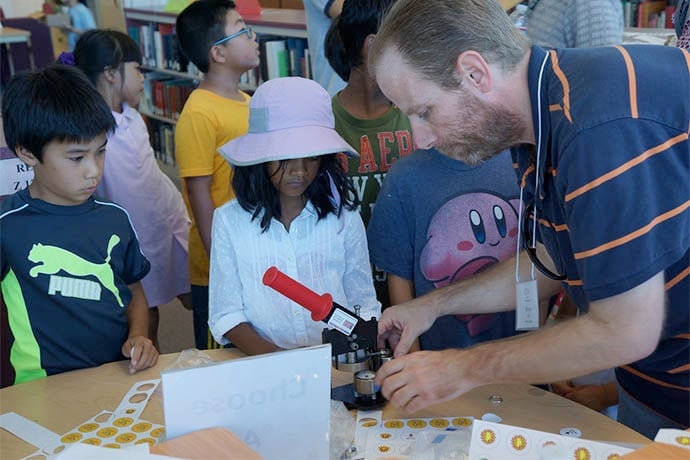Students can see hands on basic physics lessons with robots, for example, while adults can learn skills for fun and to expand their work skills. Actively making things also is a great way to balance off all our time spent on passive online and digital experiences.
Where do you begin if you want to create a space for people to make things in your school or community library? There are hundreds of articles, many collections of links, and lots of books published. Understanding what maker spaces are, how they work, and how to be successful, takes a lot of effort to find and validate. It’s also true some projects don’t require full makerspaces with every technology and a good budget. Teachers (and parents) can set up projects with a minimum of tools and a bit of planning.
Here are a few resources, which lead to many more ideas and resources, vetted by experienced teachers and librarians who have created maker spaces and projects for their communities.
Colleen Graves Makerspace Resources and Programming Ideas
Colleen is a high school teacher and librarian who shares her extensive experiences making things with students on her blog, resource page, and a book published fall 2016 (The Big Book of Makerspace Projects). Her resource page includes not only the expected links to her content but also camps where you can learn hands on, books she has read and vetted, blogs and Twitter hash tags to follow, and perhaps most interesting, down at the bottom of the page, a month by month list with links to programming ideas for makerspaces.
School Library Journal Maker Resources
Their May 2015 Maker Issue included an excellent list of books about makerspaces, as well as articles about the merits of different technologies and programming options. The magazine also includes at least one article about using librarires to make crafts which require little or no technology. Making things does not have to involve electricity (although it can) and extending the idea of making to include crafts, fashion, and other materials also broadens the audience for making things.
Makerspace for Education
This website, created by Canadian teachers but useful for anyone, provides a thorough description of makerspaces and how they fit into educational theory, as well as hands on projects contributed by teachers and information about technologies which could be included in a makerspace. Much of the value of this site is in the links within articles, for example, links to electronic textile resources mentioned in an article about Lilypad, an electronic system you can program and sew into clothing and textiles.
Learn More
Colleen Graves Makerspace Resources and Programming Ideas
https://colleengraves.org/makerspace-resources-and-programming-ideas/
https://colleengraves.org/
https://colleengraves.org/bigmakerbook/
School Library Journal
http://www.slj.com/2015/05/collection-development/maker-bookshelf-a-starter-collection-for-current-and-aspiring-makebrarians-the-maker-issue/
http://www.slj.com/features/the-maker-issue-slj-2015/
Makerspace for Education
http://www.makerspaceforeducation.com/
K-12 MakerEd
http://k12makers.org/
http://k12makers.org/list-of-makerspaces/
Eye Candy and Secret Sauce: Ten Tips for Launching a School Maker Faire
Written by a Maker Faire employee, describes some of their lessons learned.
https://www.edsurge.com/news/2016-05-17-eye-candy-and-secret-sauce-ten-tips-for-launching-a-school-maker-faire
Maker Ed
http://makered.org/
http://makered.org/resources/directory/
Library as Incubator
http://www.libraryasincubatorproject.org/
http://www.libraryasincubatorproject.org/?cat=17
Makerspace Groups on Facebook
https://www.facebook.com/groups/librarymaker
https://www.facebook.com/groups/215892381802232/
https://www.facebook.com/groups/startup.library

